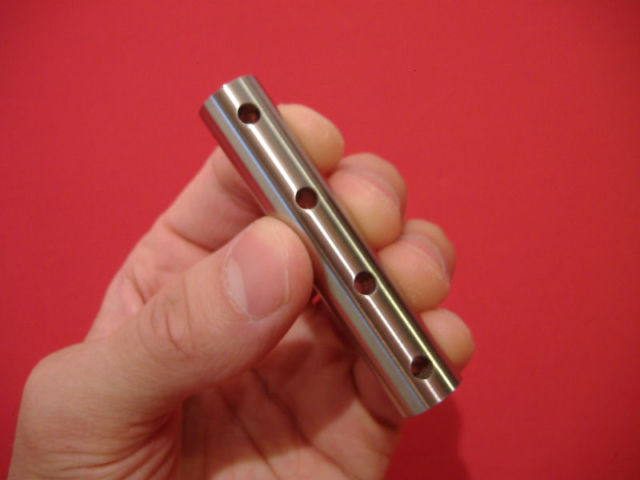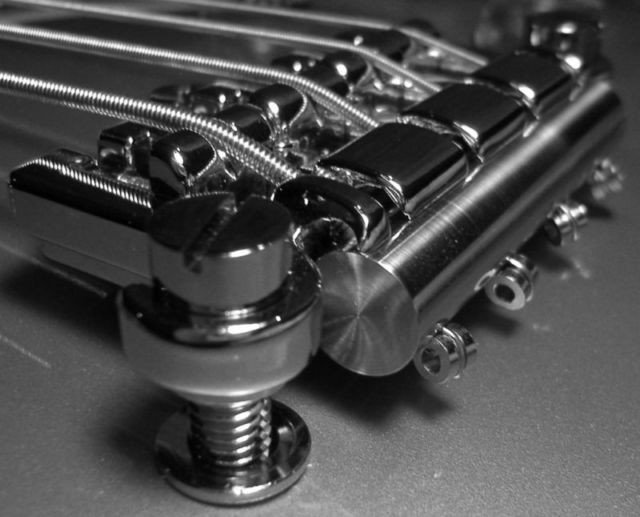Switching instruments can be a game-changer for any musician. For me, the move from a Squier Jaguar to the Epiphone EB-0 bass guitar was transformative. As a player at guitarplayers.net, I want to share my experience with this unique bass, focusing on why it might be the right choice for you, especially if you’re looking at a Bass Guitar Epiphone.
What immediately drew me to the Epiphone EB-0? Its comfortable size and dimensions are perfect for players who find standard long-scale basses a stretch. The shorter scale and slim neck make navigating the fretboard incredibly easy. I also appreciate its simplicity: a single passive pickup and just two control knobs—volume and tone. This bass is all about getting back to basics, letting your amp and pedals shape your sound.
However, my journey with the EB-0 wasn’t without its bumps. Thinking I could handle the setup myself, just like with previous basses, I quickly learned that the Epiphone EB-0 is a different beast.
The DIY Setup Attempt and the Need for a Pro
Like many players, I’m accustomed to tweaking my instruments. But with the Epiphone EB-0, my usual DIY approach led to frustration. I soon realized this bass requires a more specialized touch. That’s when I decided to seek professional help, a decision that saved me a lot of headaches and ultimately enhanced my playing experience. For a reasonable $60, Alex Allgood at Milwaukee Lutherie expertly set up my EB-0, and it was worth every penny. If you’re in the Milwaukee area and need top-notch guitar or bass work, I highly recommend them.
Navigating the Adjustments of the Epiphone EB-0 Bass
Setting up the Epiphone EB-0 involves understanding some of its unique features, particularly the truss rod and bridge system. Here’s a breakdown of the adjustments I encountered:
Truss Rod: Understanding Dual Action
My initial mistake was approaching the truss rod adjustment as I would with my previous basses. The Epiphone EB-0 features a dual-action truss rod, which is different from the single-action rods I was used to. While the bass comes with an Allen key and basic instructions, the nuances of a dual-action system require more finesse. I learned this the hard way after a minor over-adjustment. For those unfamiliar, a dual-action truss rod can bend the neck in both directions, offering more precise control over neck relief, but also demanding a more cautious approach. If you’re unsure, like I was, seeking a professional setup is definitely the way to go.
String Height: The 3-Point Bridge and Action
Adjusting the string action on the Epiphone EB-0’s 3-Point Bridge was another learning curve. Unlike bridges where you adjust each string individually, the 3-Point Bridge adjusts string height for each side using just two screws. While seemingly simpler, finding the optimal settings required some experimentation. My standard action settings of 4/64th for the E and G strings and 5/64 for the A and D strings, which worked well on other basses, resulted in significant fret buzz on the EB-0.
 Close-up of the Gibson/Epiphone Bass Bridge Mod-Bar installed on an Epiphone EB-0 bass guitar, showing how it addresses string threading issues.
Close-up of the Gibson/Epiphone Bass Bridge Mod-Bar installed on an Epiphone EB-0 bass guitar, showing how it addresses string threading issues.
Consulting recommended settings for the EB-0 revealed a slightly higher action was necessary. Initially, I thought these settings might feel too high, but due to the shorter scale and looser string tension of the EB-0, the higher action is surprisingly comfortable and eliminates fret buzz.
Recommended Action at the 12th Fret:
| Treble Side | Bass Side |
|---|---|
| 5/64 | 7/64 |
Nut Adjustment: String Gauge Considerations
The Epiphone EB-0 comes stock with light gauge round wound strings. However, I prefer the feel and tone of flat wound strings, specifically standard gauge. Switching to thicker flatwounds meant the strings didn’t sit properly in the nut grooves, as they were cut for thinner strings. This is another adjustment best left to a professional to ensure proper string spacing and prevent buzzing or binding.
Intonation: Addressing the 3-Point Bridge Challenge
One common complaint about the Epiphone EB-0 and its 3-Point Bridge is the difficulty in achieving accurate intonation. Many players also point out that the string windings at the ball end can sit over the saddles, negatively impacting tone and sustain. While some opt for a complete bridge replacement like the SuperTone Gibson Bass Replacement Bridge by Hipshot, I chose a more economical approach recommended in several reviews: the Gibson/Epiphone Bass Bridge Mod-Bar.
 The Gibson/Epiphone Bass Bridge Mod-Bar fully installed on an Epiphone EB-0 bass, demonstrating its position and function on the instrument.
The Gibson/Epiphone Bass Bridge Mod-Bar fully installed on an Epiphone EB-0 bass, demonstrating its position and function on the instrument.
This Mod-Bar effectively addresses the issue of string windings over the saddles, improving sustain and clarity. While it significantly improved intonation, I found I needed a bit more length on the 3rd and 4th strings. My solution was to use the small square beads that come with Labella Flatwound strings (originally for string identification) and slip them onto the EB-0 strings at the ball end. This pushed the string windings just behind the saddles, further refining the intonation. While the SuperTone Bridge remains a potential future upgrade, the Mod-Bar offered a cost-effective and noticeable improvement.
Hardware Choices and Personal Touches
Beyond setup, personalizing your bass guitar epiphone often involves hardware choices. Like many players, swapping out the factory strings is a standard practice. While I usually opt for Labella Flatwound strings, short-scale versions were unavailable at the time, leading me to try Dunlop Flatwound Stainless Steel Electric Bass Strings (Short Scale). These Dunlops deliver a similar Motown and Blues-inspired tone that I prefer.
One area where the Epiphone EB-0 falls short is the tuners. They are functional but feel low-ratio, requiring a very delicate touch for precise tuning. Upgrading to Hipshot tuners and potentially adding a Hipshot Bass Extender Key is on my list to improve tuning stability and drop-tuning capabilities. On a positive note, the strap retainers are surprisingly robust. Adding simple rubber washer strap locks provided ample security.
The Good, The Bad, and Yes, Even The Ugly of the Epiphone EB-0
Let’s break down the pros and cons of the Epiphone EB-0 based on my experience:
The Good:
- Fantastic Passive Pickup Tone: The Fat Sidewinder Humbucker pickup delivers a powerful and warm tone, and being passive, it eliminates the need for batteries, simplifying things.
- Simplicity in Controls: With just volume and tone knobs, the EB-0 is wonderfully straightforward. This minimalist approach keeps you focused on playing and shaping your sound through your amp and pedals.
- Comfortable Neck and Scale Length: The slim neck and 30.5″ short scale are a dream for players with smaller hands or those who prefer less stretch. It’s even thinner than a Jazz bass neck, making it incredibly comfortable for extended playing sessions.
- Lightweight Body: This bass is incredibly light, making it perfect for long gigs or players with shoulder or back issues. It’s a joy to wear for hours on end.
- Sturdy Strap Retainers: As mentioned, the stock strap retainers are surprisingly solid, providing a secure foundation for your strap.
- Easy String Height Adjustment: Despite the initial learning curve, once understood, the 3-Point Bridge makes adjusting string height relatively straightforward.
The Bad:
- Complex Setup Required: This isn’t a bass you can easily set up yourself, especially if you’re unfamiliar with dual-action truss rods and 3-Point bridges. Even many standard music shops might not have the expertise needed. Seeking a luthier or bass specialist is highly recommended.
- Intonation Challenges with Stock Bridge: The 3-Point Bridge placement can lead to intonation issues without modifications like the Mod-Bar. It’s practically a necessary upgrade for accurate tuning across the fretboard.
- Low-Ratio Tuners: The stock tuners are a weak point, making precise tuning a bit finicky. Upgrading is highly recommended for serious players.
The Ugly:
- Pickguard Sticker Residue: Removing the sticker from the pickguard was surprisingly difficult and messy, and I ended up scratching the pickguard in the process. A minor annoyance, but worth noting.
- Bridge Metal Susceptibility to Marks: The metal on the 3-Point Bridge seems quite soft and easily marked or scratched during adjustments. This is purely cosmetic but something to be aware of.
Final Verdict: Is the Epiphone EB-0 Bass Worth It?
 Live performance photo of a musician playing an Epiphone EB-0 bass guitar on stage, showcasing the bass in a gig setting.
Live performance photo of a musician playing an Epiphone EB-0 bass guitar on stage, showcasing the bass in a gig setting.
Despite the setup challenges and minor shortcomings, the Epiphone EB-0 is a fantastic bass guitar epiphone for the price. With a few key upgrades and a professional setup, it transforms into a truly great instrument with a distinctive and enjoyable sound. The playability, especially for those who prefer short-scale basses, is exceptional. While it might require a little extra investment in setup and modifications, the Epiphone EB-0 delivers a lot of value and a unique playing experience.
If you’ve played or owned an Epiphone EB-0, I’d love to hear about your experiences and any tips or modifications you’ve made. Share your thoughts in the comments below!
